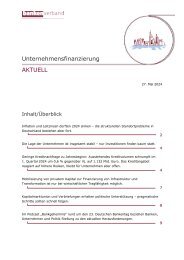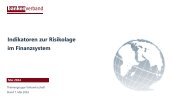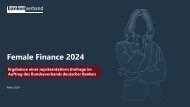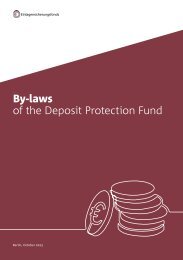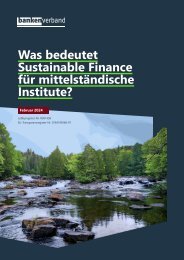Regulation of shadow banking
Shadow banking is given a large share of the blame for the financial crisis. This perception raises the question of what kind of shadow banking system should remain in place in the future.
Shadow banking is given a large share of the blame for the financial crisis. This perception raises the question of what kind of shadow banking system should remain in place in the future.
Create successful ePaper yourself
Turn your PDF publications into a flip-book with our unique Google optimized e-Paper software.
6<br />
This would mean that non-bank SIFIs would be subject<br />
to the same capital and leverage requirements as those<br />
applying to banks. Section 165d <strong>of</strong> the DFA requires<br />
every non-bank SIFI to submit a resolution plan to the<br />
Federal Deposit Insurance Corporation (FDIC) and the<br />
Federal Reserve Board.<br />
Assessment<br />
In the US, the policy framework for non-bank<br />
SIFIs is therefore being organised by applying<br />
regulatory requirements for banks to the non-bank<br />
financial sector. This rather unusual approach to<br />
dealing with <strong>shadow</strong> <strong>banking</strong> entities can mainly<br />
be explained by the fact that the DFA was drawn<br />
up as a rapid response to the financial crisis.<br />
The FSB’s proposals go far beyond the already<br />
adopted requirements for <strong>shadow</strong> <strong>banking</strong><br />
entities. Owing not only to the diversity <strong>of</strong><br />
<strong>shadow</strong> <strong>banking</strong> entities, but also to differences<br />
in legal regimes and, not least, to growing<br />
political resistance, the recommendations are<br />
totally non-binding. It will therefore be down to<br />
each individual jurisdiction to act on the FSB’s<br />
recommendations and incorporate them into<br />
national legislation. It will also be interesting to<br />
see whether the exchange <strong>of</strong> information between<br />
supervisors will prove an adequate instrument for<br />
avoiding damaging regulatory divergence.<br />
The DFA’s strategy for non-bank SIFIs also<br />
envisages that, once a company is identified as<br />
a non-bank SIFI, it will be treated by supervisors<br />
like a bank. Irrespective <strong>of</strong> the existing supervisory<br />
structure, non-bank SIFIs will automatically be<br />
subject to oversight by the Federal Reserve Board.<br />
The already convoluted structure <strong>of</strong> US financial<br />
market supervision is thus likely to become even<br />
more confusing. The Federal Reserve Board has no<br />
experience <strong>of</strong> supervising non-banks, so conflicts<br />
with the responsible specialist supervisory bodies<br />
cannot be ruled out.<br />
By contrast, the approach taken by the FSB and<br />
the EU seems much more methodical. Unlike in<br />
the US, those responsible began by analysing the<br />
potential risks emanating from <strong>shadow</strong> <strong>banking</strong>,<br />
and only then went on to draft regulation. In the<br />
AIFMD, the EU has created a dedicated instrument<br />
for regulating <strong>shadow</strong> <strong>banking</strong> entities, among<br />
other things. The directive sets out capital, liquidity<br />
and leverage requirements along the lines <strong>of</strong> the<br />
Basel framework for banks, but tailored to AIFMs.<br />
26 <strong>Regulation</strong> <strong>of</strong> <strong>shadow</strong> <strong>banking</strong>






